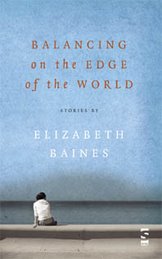Maybe I should have had Milan Kundera with me when my novel The Birth Machine was first published.
Like much of my work, The Birth Machine is about knowledge and power, about the different kinds of knowledge, empirical and intuitive, the knowledge of science and the knowledge of myths and dreams, and the question of where, between them all, the truth, and the power, lie. Well, this is what it's about as far as I'm concerned. It's also, for me, a novel about viewpoint, about objectivity and subjectivity, and in this, to me, the structure is all-important: I began with an objective, scientific (medical) viewpoint and slowly circled inwards to the subjective viewpoint of the 'object' patient, and through into memory and even further into dream.
But, after we'd done the deal, after the publisher had said how much she absolutely loved my novel, she told me: 'We really need you to change the beginning. We need to begin with the viewpoint of the woman patient in order to appeal to our market, ie women, and allow them to identify.'
Well, this was a feminist publisher, and I wasn't so naive that I hadn't realised that she might see my book more narrowly in terms of male power and the condition of women (or indeed that the context of a feminist publishing house might push it towards this narrower interpretation), but I was pretty shocked by this indication that the book would only be marketed to women, and deeply shocked that my structural stratagems must be discarded and with them any chance of my thematic intentions being realised. (And they must: the publisher did not feel she could go ahead unless I made the change.)
 Well, I made the change. I was a new, scared writer after all, and my agent had already tried to sell the book to mainstream publishers, but the very thing which had attracted The Women's Press, the central situation of a high-tech birth, had put those other publishers off, and, insecure as I was, I didn't think anyone else would publish it. Apart from which, The Women's Press had already threatened not to go ahead with the book as I'd turned out in real life to be Not a Good Feminist in the eyes of their 'market' (which was thus diminishing before my eyes to 'Angry Feminists in the Know'). I was already on a last warning, and to get this book published, a satire about a woman making the mistake of being a Good Girl according to others' rules, I had to be a good girl according my feminist publishers' rules. And the novel was made more 'accessible', 'identifiable-with' - in post-structuralist terms less writerly and more readerly - and the political/aesthetic challenge I had intended was dissipated.
Well, I made the change. I was a new, scared writer after all, and my agent had already tried to sell the book to mainstream publishers, but the very thing which had attracted The Women's Press, the central situation of a high-tech birth, had put those other publishers off, and, insecure as I was, I didn't think anyone else would publish it. Apart from which, The Women's Press had already threatened not to go ahead with the book as I'd turned out in real life to be Not a Good Feminist in the eyes of their 'market' (which was thus diminishing before my eyes to 'Angry Feminists in the Know'). I was already on a last warning, and to get this book published, a satire about a woman making the mistake of being a Good Girl according to others' rules, I had to be a good girl according my feminist publishers' rules. And the novel was made more 'accessible', 'identifiable-with' - in post-structuralist terms less writerly and more readerly - and the political/aesthetic challenge I had intended was dissipated.Aesthetically I felt ruined, and in some ways I didn't even want to own the novel as it was published. For as Kundera says in his new book: the beauty of a novel is inseparable from its architecture; I say "beauty" because the composition is not merely a technical skill; it carries within it an author's originality of style. Whenever I thought about 'The Birth Machine' it was the original version I thought about, and whenever I read from the book to audiences, I always read the original first chapter which had been relegated to later in the published version. So when the book went out of print and the rights reverted to me, I published a revised edition, subtitled 'The Author's Cut', with the original structure reinstated.
 But by then, to many people, including academics who had written about it, 'The Birth Machine' was indeed the first published version - and many had written to me to tell me how much it had meant to them. What did this mean? In the Author's Note to the revised edition I say this:
But by then, to many people, including academics who had written about it, 'The Birth Machine' was indeed the first published version - and many had written to me to tell me how much it had meant to them. What did this mean? In the Author's Note to the revised edition I say this: Of course in the end it's not for me, as the writer, to say which version is better, or whether either version fulfils completely the authorial/editorial intention behind its creation, and whether indeed it matters if it doesn't - all this has to be up to readers.
But I think I was still running scared. After all, I had grabbed the first chance to reinstate the original version. And what do I think now? Well, that 'The Author's Cut' is the real version.












No comments:
Post a Comment